Guinness
Guinness (/ˈɡɪnɪs/) is a dark Irish dry stout that originated in the brewery of Arthur Guinness at St. James's Gate, Dublin, Ireland, in 1759. It is one of the most successful alcohol brands worldwide, brewed in almost 50 countries, and available in over 120.[1][2] Sales in 2011 amounted to 850 million litres (220,000,000 US gal).[1] It is popular with the Irish, both in Ireland and abroad. In spite of declining consumption since 2001,[3] it is still the best-selling alcoholic drink in Ireland[4] where Guinness & Co. Brewery makes almost €2 billion worth of beer annually.
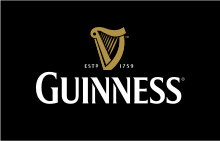 The original logo, est'd 1759 | |
| Type | Dry stout (beer) |
|---|---|
| Manufacturer | Diageo |
| Country of origin | Republic of Ireland |
| Introduced | 1759 |
| Colour | Dark ruby red |
| Flavour | Tangy |
| Related products | Harp Lager, Hop House 13, Rockshore |
| Website | www |
The Guinness Storehouse is a tourist attraction at St. James's Gate Brewery in Dublin, Ireland. Since opening in 2000, it has received over 20 million visitors.
Guinness's flavour derives from malted barley and roasted unmalted barley, a relatively modern development, not becoming part of the grist until the mid-20th century. For many years, a portion of aged brew was blended with freshly brewed beer to give a sharp lactic acid flavour. Although Guinness's palate still features a characteristic "tang", the company has refused to confirm whether this type of blending still occurs. The draught beer's thick, creamy head comes from mixing the beer with nitrogen and carbon dioxide.[5]
The company moved its headquarters to London at the beginning of the Anglo-Irish Trade War in 1932. In 1997, Guinness plc merged with Grand Metropolitan to form the British multinational alcoholic-drinks producer Diageo plc, based in London.
History
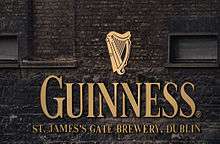
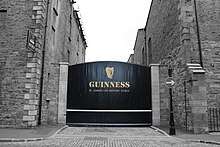
.jpg)
Arthur Guinness started brewing ales in 1759 at the St. James's Gate Brewery, Dublin. On 31 December 1759, he signed a 9,000 year lease at £45 per annum for the unused brewery.[6][7][8] Ten years later, on 19 May 1769, Guinness first exported his ale: he shipped six-and-a-half barrels to Great Britain.
Arthur Guinness started selling the dark beer porter in 1778.[9] The first Guinness beers to use the term were Single Stout and Double Stout in the 1840s.[10] Throughout the bulk of its history, Guinness produced only three variations of a single beer type: porter or single stout, double or extra and foreign stout for export.[11] "Stout" originally referred to a beer's strength, but eventually shifted meaning toward body and colour.[12] Porter was also referred to as "plain", as mentioned in the famous refrain of Flann O'Brien's poem "The Workman's Friend": "A pint of plain is your only man."[13]
Already one of the top-three British and Irish brewers, Guinness's sales soared from 350,000 barrels in 1868 to 779,000 barrels in 1876.[11] In October 1886 Guinness became a public company, and was averaging sales of 1.138 million barrels a year. This was despite the brewery's refusal to either advertise or offer its beer at a discount.[11] Even though Guinness owned no public houses, the company was valued at £6 million and shares were 20 times oversubscribed, with share prices rising to a 60 per cent premium on the first day of trading.[11]
The breweries pioneered several quality control efforts. The brewery hired the statistician William Sealy Gosset in 1899, who achieved lasting fame under the pseudonym "Student" for techniques developed for Guinness, particularly Student's t-distribution and the even more commonly known Student's t-test.
By 1900 the brewery was operating unparalleled welfare schemes for its 5,000 employees.[11] By 1907 the welfare schemes were costing the brewery £40,000 a year, which was one-fifth of the total wages bill.[11] The improvements were suggested and supervised by Sir John Lumsden. By 1914, Guinness was producing 2.652 million barrels of beer a year, which was more than double that of its nearest competitor Bass, and was supplying more than 10 per cent of the total UK beer market.[11]
Before 1939, if a Guinness brewer wished to marry a Catholic, his resignation was requested.[14] According to Thomas Molloy, writing in the Irish Independent, "It had no qualms about selling drink to Catholics but it did everything it could to avoid employing them until the 1960s."[15]
Guinness thought they brewed their last porter in 1973.[12] In the 1970s, following declining sales, the decision was taken to make Guinness Extra Stout more "drinkable". The gravity was subsequently reduced, and the brand was relaunched in 1981.[16] Pale malt was used for the first time, and isomerised hop extract began to be used.[16] In 2014, two new porters were introduced: West Indies Porter and Dublin Porter.[17]
Guinness acquired the Distillers Company in 1986.[18] This led to a scandal and criminal trial concerning the artificial inflation of the Guinness share price during the takeover bid engineered by the chairman, Ernest Saunders.[19] A subsequent £5.2 million success fee paid to an American lawyer and Guinness director, Tom Ward, was the subject of the case Guinness plc v Saunders, in which the House of Lords declared that the payment had been invalid.[20]
In the 1980s, as the IRA's bombing campaign spread to London and the rest of Britain, Guinness considered scrapping the Harp as its logo.[15]
The company merged with Grand Metropolitan in 1997 to form Diageo.[21] Due to controversy over the merger, the company was maintained as a separate entity within Diageo and has retained the rights to the product and all associated trademarks of Guinness.

The Guinness brewery in Park Royal, London closed in 2005. The production of all Guinness sold in the UK and Ireland was moved to St. James's Gate Brewery, Dublin.[22]
Guinness has also been referred to as "that black stuff".[23] Guinness had a fleet of ships, barges and yachts.[24] The Irish Sunday Independent newspaper reported on 17 June 2007 that Diageo intended to close the historic St James's Gate plant in Dublin and move to a greenfield site on the outskirts of the city.[25] This news caused some controversy when it was announced.
The following day, the Irish Daily Mail ran a follow-up story with a double page spread complete with images and a history of the plant since 1759. Initially, Diageo said that talk of a move was pure speculation but in the face of mounting speculation in the wake of the Sunday Independent article, the company confirmed that it is undertaking a "significant review of its operations". This review was largely due to the efforts of the company's ongoing drive to reduce the environmental impact of brewing at the St James's Gate plant.[26]
On 23 November 2007, an article appeared in the Evening Herald, a Dublin newspaper, stating that the Dublin City Council, in the best interests of the city of Dublin, had put forward a motion to prevent planning permission ever being granted for development of the site, thus making it very difficult for Diageo to sell off the site for residential development.
On 9 May 2008, Diageo announced that the St James's Gate brewery will remain open and undergo renovations, but that breweries in Kilkenny and Dundalk will be closed by 2013 when a new larger brewery is opened near Dublin. The result will be a loss of roughly 250 jobs across the entire Diageo/Guinness workforce in Ireland.[27] Two days later, the Sunday Independent again reported that Diageo chiefs had met with Tánaiste Mary Coughlan, the deputy leader of the Government of Ireland, about moving operations to Ireland from the UK to benefit from its lower corporation tax rates. Several UK firms have made the move in order to pay Ireland's 12.5 per cent rate rather than the UK's 28 per cent rate.[28] Diageo released a statement to the London stock exchange denying the report.[29] Despite the merger that created Diageo plc in 1997, Guinness has retained its right to the Guinness brand and associated trademarks and thus continues to trade under the traditional Guinness name despite trading under the corporation name Diageo for a brief period in 1997.
In November 2015 it was announced that Guinness are planning to make their beer suitable for consumption by vegetarians and vegans by the end of 2016 through the introduction of a new filtration process at their existing Guinness Brewery that avoids the need to use isinglass from fish bladders to filter out yeast particles.[30][31] This went into effect in 2017, per the company's FAQ webpage where they state: "Our new filtration process has removed the use of isinglass as a means of filtration and vegans can now enjoy a pint of Guinness. All Guinness Draught in keg format is brewed without using isinglass. Full distribution of bottle and can formats will be in place by the end of 2017, so until then, our advice to vegans is to consume the product from the keg format only for now." [32]
Composition
Guinness stout is made from water, barley, roast malt extract, hops, and brewer's yeast. A portion of the barley is roasted to give Guinness its dark colour and characteristic taste. It is pasteurised and filtered.[33]
Until the late 1950s Guinness was still racked into wooden casks. In the late 1950s and early 1960s, Guinness ceased brewing cask-conditioned beers and developed a keg brewing system with aluminium kegs replacing the wooden casks; these were nicknamed "iron lungs".[34] Until 2016 the production of Guinness, as with many beers, involved the use of isinglass made from fish. Isinglass was used as a fining agent for settling out suspended matter in the vat. The isinglass was retained in the floor of the vat but it was possible that minute quantities might be carried over into the beer.[35][36][37][38] Diageo announced in February 2018 that the use of isinglass in draught Guinness was to be discontinued and an alternative clarification agent would be used instead. This has made draught Guinness acceptable to vegans and vegetarians.
Present day Guinness
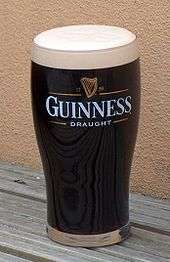
Arguably its biggest change to date, in 1959 Guinness began using nitrogen, which changed the fundamental texture and flavour of the Guinness of the past as nitrogen bubbles are much smaller than CO2, giving a "creamier" and "smoother" consistency over a sharper and traditional CO2 taste. This step was taken after Michael Ash – a mathematician turned brewer – discovered the mechanism to make this possible.
Nitrogen is less soluble than carbon dioxide, which allows the beer to be put under high pressure without making it fizzy. High pressure of the dissolved gas is required to enable very small bubbles to be formed by forcing the draught beer through fine holes in a plate in the tap, which causes the characteristic "surge" (the widget in cans and bottles achieves the same effect). This "widget" is a small plastic ball containing the nitrogen. The perceived smoothness of draught Guinness is due to its low level of carbon dioxide and the creaminess of the head caused by the very fine bubbles that arise from the use of nitrogen and the dispensing method described above. "Foreign Extra Stout" contains more carbon dioxide,[5] causing a more acidic taste.
Contemporary Guinness Draught and Extra Stout are weaker than they were in the 19th century, when they had an original gravity of over 1.070. Foreign Extra Stout and Special Export Stout, with abv of 7.5% and 9% respectively, are perhaps closest to the original in character.[39]
Although Guinness may appear to be black, it is officially a very dark shade of ruby.[40]
The most recent change in alcohol content from the Import Stout to the Extra Stout was due to a change in distribution through North American market. Consumer complaints have influenced recent distribution and bottle changes. [41]
Health
Studies claim that Guinness can be beneficial to the heart. Researchers found that "'antioxidant compounds' in the Guinness, similar to those found in certain fruits and vegetables, are responsible for the health benefits because they slow down the deposit of harmful cholesterol on the artery walls."[42][43]
Guinness ran an advertising campaign in the 1920s which stemmed from market research – when people told the company that they felt good after their pint, the slogan, created by Dorothy L. Sayers[44][45]–"Guinness is Good for You". Advertising for alcoholic drinks that implies improved physical performance or enhanced personal qualities is now prohibited in Ireland.[46] Diageo, the company that now manufactures Guinness, says: "We never make any medical claims for our drinks."[47]
Varieties
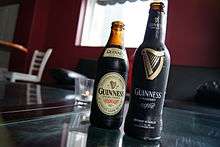
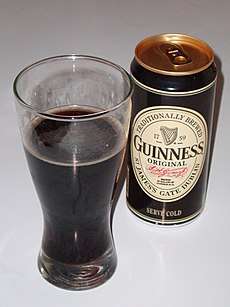
Guinness stout is available in a number of variants and strengths, which include:
- Guinness Draught, sold in kegs, widget cans, and bottles: 4.1 to 4.3% alcohol by volume (ABV); the Extra Cold is served through a super cooler at 3.5 °C (38.3 °F).[48]
- Guinness Original/Extra Stout: 4.2 to 5.6% in the United States. 5% in Canada, and most of Europe; 4.2 or 4.3% ABV in Ireland and some European countries, 4.1% in Germany, 4.8% in Namibia and South Africa, and 6% in Australia and Japan.
- Guinness Foreign Extra Stout: 7.5% ABV version sold in Europe, Africa, the Caribbean, Asia, and the United States. The basis is an unfermented but hopped Guinness wort extract shipped from Dublin, which is added to local ingredients and fermented locally. The strength can vary, for example, it is sold at 5% ABV in China, 6.5% ABV in Jamaica and East Africa, 6.8% in Malaysia, 7.5% in the United States, and 8% ABV in Singapore.[49][50] In Nigeria a proportion of sorghum is used. Foreign Extra Stout is blended with a small amount of intentionally soured beer. Formerly, it was blended with beer that soured naturally as a result of fermenting in ancient oak tuns with a Brettanomyces population; it is now made with pasteurised beer that has been soured bacterially.[51] It was previously known as West Indies Porter, then Extra Stout and finally Foreign Extra Stout.[14] It was first made available in the UK in 1990.[14]
- Guinness Special Export Stout, Commissioned by John Martin of Belgium in 1912.[52] The first variety of Guinness to be pasteurised, in 1930.[53] 8% ABV.
- Guinness Bitter, an English-style bitter beer: 4.4% ABV.
- Guinness Extra Smooth, a smoother stout sold in Ghana, Cameroon and Nigeria: 5.5% ABV.
- Malta Guinness, a non-alcoholic sweet drink, produced in Nigeria and exported to the UK, East Africa, and Malaysia.
- Guinness Zero ABV, a non-alcoholic beverage sold in Indonesia.[54]
- Guinness Mid-Strength, a low-alcohol stout test-marketed in Limerick, Ireland in March 2006[55] and Dublin from May 2007:[56] 2.8% ABV.
- Guinness Red, brewed in exactly the same way as Guinness except that the barley is only lightly roasted so that it produces a lighter, slightly fruitier red ale; test-marketed in Britain in February 2007: 4% ABV.[57]
- 250 Anniversary Stout, released in the U.S., Australia and Singapore on 24 April 2009;[58] 5% ABV.
- Guinness West Indies, a Porter which imitates the 1801 variety with notes of toffee and chocolate: 6% ABV.
In October 2005, Guinness announced the Brewhouse Series, a limited-edition collection of draught stouts available for roughly six months each. There were three beers in the series.
- Brew 39 was sold in Dublin from late 2005 until early 2006. It had the same alcohol content (ABV) as Guinness Draught, used the same gas mix and settled in the same way, but had a slightly different taste. Many found it to be lighter in taste, somewhat closer to Beamish stout than standard Irish Guinness.[59] The Beamish & Crawford Brewery was established in 1792 in the City of Cork, and was bought by Guinness in 1833.[60]
- Toucan Brew was introduced in May 2006. It was named after the cartoon toucan used in many Guinness advertisements. This beer had a crisper taste with a slightly sweet aftertaste due to its triple-hopped brewing process.
- North Star was introduced in October 2006 and sold into late 2007. Three million pints of North Star were sold in the latter half of 2007.[61]
Despite an announcement in June 2007 that the fourth Brewhouse stout would be launched in October that year,[62] no new beer appeared and, at the end of 2007, the Brewhouse series appeared to have been quietly cancelled.
In March 2006, Guinness introduced the "surger" in Britain. The surger is a plate-like electrical device meant for the home. It sends ultrasonic waves through a Guinness-filled pint glass to recreate the beer's "surge and settle" effect. The device works in conjunction with special cans of surger-ready Guinness. Guinness tried out a primitive version of this system in 1977 in New York. The idea was abandoned until 2003, when it began testing the surger in Japanese bars, most of which are too small to accommodate traditional keg-and-tap systems. Since then, the surger has been introduced to bars in Paris. Surgers are also in use in Australia, Singapore and Greece. The surger for the US market was announced on 14 November 2007; plans were to make the unit available to bars only.[63]
Withdrawn Guinness variants include Guinness's Brite Lager, Guinness's Brite Ale, Guinness Light, Guinness XXX Extra Strong Stout, Guinness Cream Stout, Guinness Gold, Guinness Pilsner, Guinness Breó (a slightly citrusy wheat beer), Guinness Shandy, and Guinness Special Light.[64]
Breó (meaning 'glow' in Irish)[65] was a wheat beer; it cost around IR£5 million to develop.
For a short time in the late 1990s, Guinness produced the "St James's Gate" range of craft-style beers, available in a small number of Dublin pubs. The beers were: Pilsner Gold, Wicked Red Ale, Wildcat Wheat Beer and Dark Angel Lager.
A brewing byproduct of Guinness, Guinness Yeast Extract (GYE), was produced until the 1950s. In the UK, a HP Guinness Sauce has recently been made available, manufactured by Heinz.[66] Kraft also licenses the name for its barbecue sauce product, Bull's-Eye Barbecue Sauce.
In March 2010, Guinness began test marketing Guinness Black Lager, a new black lager, in Northern Ireland and Malaysia.[67] As of September 2010, Guinness Black Lager is no longer readily available in Malaysia. In October 2010, Guinness began selling Foreign Extra Stout in 4 packs of bottles in the United States.[68]
Guinness Red Harvest Stout was introduced in September 2013. sold in 14.9oz widget cans: 4.1% alcohol by volume (ABV); Inspired by the ancient Celtic festival of samhain, the seasonal Guinness Red Harvest Stout has a mildly sweet velvety taste and deep red hue. Crafted with a blend of lightly roasted barley and sweet Irish malt.
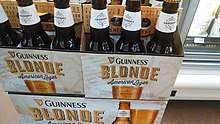
In 2014, Guinness released Guinness Blonde, a lager brewed in Latrobe, Pennsylvania using a combination of Guinness yeast and American ingredients.[69] The Guinness Brewers Project also released two craft beers, Dublin Porter and West Indies Porter.[17]
Guinness released a lager in 2015 called Hop House 13. It has become an available drink in many Irish pubs.[70] Hop House 13 is intended to have hints of apricot and peach, with malt flavour and a medium body.[71]
Pouring and serving
Before the 1960s, when Guinness adopted the current system of delivery using a nitrogen/carbon dioxide gas mixture, all beer leaving the brewery was cask-conditioned. Casks newly delivered to many small pubs were often nearly unmanageably frothy, but cellar space and rapid turnover demanded that they be put into use before they could sit for long enough to settle down. As a result, a glass would be part filled with the fresh, frothy beer, allowed to stand a minute, and then topped up with beer from a cask that had been pouring longer and had calmed down a bit.[72] With the move to nitrogen gas dispense in the 1960s, it was felt important to keep the two-stage pour ritual in order to bring better consumer acceptance of the modern nitrogen-based delivery. As Guinness has not been cask-conditioned for decades, the two-stage pour has been labeled a marketing ploy that does not actually affect the beer's taste.[73]
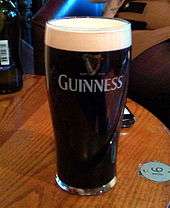
What Diageo calls the "perfect pint" of Draught Guinness is the product of a "double pour", which according to the company should take 119.53 seconds.[74][75][76][77] Guinness has promoted this wait with advertising campaigns such as "good things come to those who wait". Despite this, Guinness has endorsed the use of "Exactap", marketed by DigitalDispense USA LLC, owned in a trust by its American inventor. The "Exactap" is the fastest beer dispense system in the world and can deliver a perfectly presented Guinness, with no overfilling, in just 4 seconds.[78] There are over 600 "Exactaps" in use in Dublin stadia alone.
The brewer currently recommends that draught Guinness should be served at 6 °C (42.8 °F),[79] while Extra Cold Guinness should be served at 3.5 °C (38.6 °F).[80] Prior to the 21st century it was popular to serve Guinness at cellar temperature (about 13 °C) and some drinkers preferred it at room temperature (about 20 °C).[81]
According to Esquire Magazine, a pint of Guinness should be served in a slightly tulip shaped pint glass[82] (as opposed to the taller European tulip glass or 'Nonic' glass, which contains a ridge approx 3/4 of the way up the glass). To begin the pour, the server holds the glass at a 45° angle below the tap and fills the glass 3/4 full.[82] On the way out of the tap, the beer is forced at high speed through a five-hole disc restrictor plate in the end of the tap,[82] creating friction and forcing the creation of small nitrogen bubbles[82] which form a creamy head. After allowing the initial pour to settle, the server fills the remainder of the glass until the head forms a slight dome over the top of the glass.[82]
In April 2010, Guinness redesigned the Guinness pint glass for the first time in a decade. The new glass is taller and narrower than the previous one and features a bevel design. The new glasses are planned to gradually replace the old ones.[83]
Sinking bubbles
When Guinness is poured, the gas bubbles appear to travel downwards in the glass.[84] The effect is attributed to drag; bubbles that touch the walls of a glass are slowed in their travel upwards. Bubbles in the centre of the glass are, however, free to rise to the surface, and thus form a rising column of bubbles. The rising bubbles create a current by the entrainment of the surrounding fluid. As beer rises in the centre, the beer near the outside of the glass falls. This downward flow pushes the bubbles near the glass towards the bottom. Although the effect occurs in any liquid, it is particularly noticeable in any dark nitrogen stout, as the drink combines dark-coloured liquid and light-coloured bubbles.[85][86]
A study published in 2012 revealed that the effect is due to the particular shape of the glass coupled with the small bubble size found in stout beers.[87][88][89][90][91] If the vessel widens with height then bubbles will sink along the walls – this is the case for the standard pint glass. Conversely, in an anti-pint (i.e. if the vessel narrows with height) bubbles will rise along the walls.[92]
Culinary uses
Guinness is frequently used as an ingredient in recipes, often to add a seemingly authentic Irish element to the menus of Irish-themed pubs[93] in the United States, where it is stirred into everything from french toast to beef stew.[94]
A popular, authentic, Irish course featuring Guinness is the "Guinness and Steak Pie". The recipe includes many common Irish herbs, as well as beef brisket, cheeses, and a can of Guinness.[95]
Advertising
The Guinness harp motif is modelled on the Trinity College Harp. It was adopted in 1862 by the incumbent proprietor, Benjamin Lee Guinness. Harps have been a symbol of Ireland at least since the reign of Henry VIII. Guinness registered their harp as a trademark shortly after the passing of the Trade Marks Registration Act of 1875. It faces right instead of left, and so can be distinguished from the Irish coat of arms.[96]
Since the 1930s, in the face of falling sales, Guinness has had a long history of marketing campaigns, from television advertisements to beer mats and posters. Before then, Guinness had almost no advertising, instead allowing word of mouth to sell the product.[97]
The most notable and recognisable series of advertisements was created by S.H. Benson's advertising, primarily drawn by the artist John Gilroy, in the 1930s and 1940s.[97] Benson created posters that included phrases such as "Guinness for Strength", "Lovely Day for a Guinness", "Guinness Makes You Strong", "My Goodness My Guinness" (or, alternatively, "My Goodness, My Christmas, It's Guinness!"), and most famously, "Guinness is Good For You".[97] The posters featured Gilroy's distinctive artwork and more often than not featured animals such as a kangaroo, ostrich, seal, lion and notably a toucan, which has become as much a symbol of Guinness as the harp.[97] (An advertisement from the 1940s ran with the following jingle: "Toucans in their nests agree/Guinness is good for you/Try some today and see/What one or toucan do.") Dorothy L. Sayers and Bobby Bevan copywriters at Benson's also worked on the campaign; a biography of Sayers notes that she created a sketch of the toucan and wrote several of the adverts in question. Guinness advertising paraphernalia, notably the pastiche booklets illustrated by Ronald Ferns, attract high prices on the collectible market.[98]
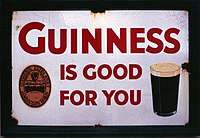
Many of the best known Guinness television commercials of the 1970s and 1980s were created by British director, Len Fulford.[100]
In 1983, a conscious marketing decision was made to turn Guinness into a "cult" beer in the UK, amidst declining sales.[101] The move halted the sales decline. The Guardian described the management of the brand:
- "they've spent years now building a brand that's in complete opposition to cheap lagers, session drinking and crowds of young men boozing in bars. They've worked very hard to help Guinness drinkers picture themselves as twinkly-eyed, Byronic bar-room intellectuals, sitting quietly with a pint and dreaming of poetry and impossibly lovely redheads running barefoot across the peat. You have a pint or two of Guinness with a slim volume of Yeats, not eight mates and a 19 pint bender which ends in tattoos, A&E [the ED] and herpes from a hen party."[102]
In the late 1980s and early 1990s, in the UK, there was a series of "darkly" humorous adverts, featuring actor Rutger Hauer, with the theme "Pure Genius", extolling its qualities in brewing and target market.
The 1994–1995 Anticipation campaign, featuring actor Joe McKinney dancing to "Guaglione" by Perez Prado while his pint settled, became a legend in Ireland and put the song to number one in the charts for several weeks. The advertisement was also popular in the UK where the song reached number two.
From 1999 to 2006, the Michael Power advertising character was the cornerstone of a major marketing campaign to promote Guinness products in Africa. The character, played by Cleveland Mitchell, was portrayed to have been born in Jamaica and raised in Great Britain.[103] By 2003, it became one of the best-known alcohol advertising campaigns in Africa. Jo Foster of the BBC referred to Power as "Africa's very own 'James Bond'".[104]
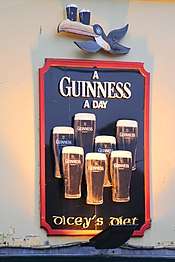
In 2000, Guinness's 1999 advertisement "Surfer" was named the best television commercial of all time, in a UK poll conducted by The Sunday Times and Channel 4. This advertisement is inspired by the famous 1980s Guinness TV and cinema ad, "Big Wave", centred on a surfer riding a wave while a bikini-clad sun bather takes photographs. The 1980s advertisement not only remained a popular iconic image in its own right; it also entered the Irish cultural memory through inspiring a well known line in Christy Moore's song "Delirium Tremens" (1985). "Surfer" was produced by the advertising agency Abbott Mead Vickers BBDO; the advertisement can be downloaded from their website.[105]
Guinness won the 2001 Clio Award as the Advertiser of the Year, citing the work of five separate ad agencies around the world.[106]
In 2002, Guinness applied the Michael Power formula to Asia with the character Adam King.[107] The campaign featured such tag lines as: "Everyday someone, somewhere achieves something new. Sometimes on a grand, dramatic scale. Sometimes on a more personal scale." As of 2004, Guinness ranked among the top three beer labels in Singapore and Malaysia, with a 20 per cent marketshare across Southeast Asia. Malaysia was the brand's third largest market in the region and sixth largest market worldwide.[108]
In 2003, the Guinness TV campaign featuring Tom Crean won the gold Shark Award at the International Advertising Festival of Ireland,[109] while in 2005 their Irish Christmas campaign won a silver Shark.[110] This TV ad has been run every Christmas since its debut in December 2004 and features pictures of snow falling in places around Ireland, evoking the James Joyce story "The Dead", finishing at St. James's Gate Brewery with the line: "Even at the home of the black stuff they dream of a white one".[111][112]
Their UK commercial "noitulovE", first broadcast in October 2005, was the most-awarded commercial worldwide in 2006.[113] In it, three men drink a pint of Guinness, then begin to both walk and evolve backward. Their "reverse evolution" passes through an ancient Homo sapiens, a monkey, a flying lemur, a pangolin, an ichthyosaur, and a velociraptor, until finally settling on a mud skipper drinking dirty water, which then expresses its disgust at the taste of the stuff, followed by the line: "Good Things Come To Those Who Wait". This was later modified to have a different endings to advertise Guinness Extra Cold, often shown as "break bumpers" at the beginning and end of commercial breaks. The second endings show either the Homo sapiens being suddenly frozen in a block of ice, the ichthyasaurs being frozen while swimming, or the pool of muddy water freezing over as the mud skipper takes a sip, freezing his tongue to the surface.
_(1727997539).jpg)
Two further advertisements in 2006 and early 2007, "Hands" and "St. Patrick's Hands", were created by animator Michael Schlingmann for Abbott Mead Vickers BBDO. They feature a pair of hands, animated in stop motion under a rostrum camera. "Hands" focuses on the 119.53 seconds it takes to pour a pint, and "St. Patrick's Hands is a spoof of Riverdance, with the animated hands doing the dancing.
In 2006, Diageo, owner of the Guinness brand, replaced the Michael Power campaign with the "Guinness Greatness" campaign, which they claim emphasises the "drop of greatness" in everyone, in contrast to the high-tension heroics of the Power character.[107]
Guinness' 2007 advertisement, directed by Nicolai Fuglsig and filmed in Argentina, is entitled "Tipping Point". It involves a large-scale domino chain reaction and, with a budget of £10 million, was the most expensive advertisement by the company at that point.[114]
The 2000s also saw a series of television advertisements, entitled "Brilliant!" in which two crudely animated Guinness brewmasters would discuss the beer, particularly the ability to drink it straight from the bottle. The two would almost always react to their discoveries with the catchphrase "Brilliant!", hence the campaign's title.
In 2009, the "To Arthur" advertisement, which started with two friends realising the company's long history, hail each other by lifting up their glasses and saying: "to Arthur!". The hailing slowing spread throughout the bar to the streets outside, and finally around the world. The advertisement ends with the voiceover: "Join the worldwide celebration, of a man named Arthur".[115]
This gave rise to the event now known as Arthur's Day. "Arthur's Day is a series of events and celebrations taking place around the world to celebrate the life and legacy of Arthur Guinness and the much-loved Guinness beer which Arthur brought to the world."[116]
Starting in 2011 the Guinness brand issued a series of Ireland-wide advertisements featuring everyday Irish people as part of their "Guinness is Good For Us" campaign referencing the iconic "Guinness is Good For You" campaign of the 1920s to 1960s.
Worldwide sales
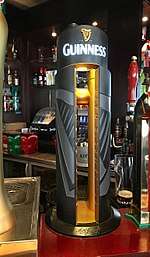
In 2006, sales of Guinness in Ireland and the United Kingdom declined 7 per cent.[117] Despite this, Guinness still accounts for more than a quarter of all beer sold in Ireland.[118] By 2015, sales were on the rise in Ireland but flat globally.[119]
Guinness began retailing in India in 2007.[120][121]
Guinness has a significant share of the African beer market, where it has been sold since 1827. About 40 per cent of worldwide total Guinness volume is brewed and sold in Africa, with Foreign Extra Stout the most popular variant. Three of the five Guinness-owned breweries worldwide are located in Africa.[122] The Michael Power advertising campaign was a critical success for Guinness in Africa, running for nearly a decade before being replaced in 2006 with "Guinness Greatness".
The beer is brewed under licence internationally in several countries, including Nigeria,[123][124] the Bahamas, Canada,[125] Cameroon, Kenya, Uganda, South Korea, Namibia, and Indonesia.[126] The unfermented but hopped Guinness wort extract is shipped from Dublin and blended with beer brewed locally.
In 2017 Guinness teamed up with AB InBev to distribute Guinness in mainland China. China is the single biggest worldwide alcohol market, especially for imported craft beers like Guinness.[127]
The UK is the only sovereign state to consume more Guinness than Ireland. The third-largest Guinness drinking nation is Nigeria, followed by the USA;[128] the United States consumed more than 950,000 hectolitres of Guinness in 2010.[118]
Merchandising
The Guinness Storehouse at St. James's Gate Brewery in Dublin is the most popular tourist attraction in Ireland (attracting over 1.7 million visitors in 2017) where a self-guided tour includes an account of the ingredients used to make the stout and a description of how it is made.[129] Visitors can sample the smells of each Guinness ingredient in the Tasting Rooms, which are coloured with a unique lighting design that emits Guinness's gold and black branding.[130]
The Guinness Book of Records started as a Guinness marketing giveaway, based on an idea of its then Managing Director, Sir Hugh Beaver. Its holding company, Guinness World Records Ltd, was owned by Guinness plc, subsequently Diageo, until 2001.
References
- "Famous Brewer Expands with National Launch of GUINNESS Black Lager – NORWALK, Conn., Aug. 24, 2011 /PRNewswire/". Connecticut, Ireland: Prnewswire.com. Retrieved 19 December 2011.
- "Why Guinness is less Irish than you think". The Economist. 16 March 2014.
- Fabb, Debbie (23 November 2007). "Last orders for Guinness?". BBC News. Retrieved 23 September 2010.
- Barry, Dan (28 August 2000). "In Ireland's Pubs, a Startling Trend". Lisdoonvarna Journal. The New York Times. Retrieved 10 April 2008.
... Guinness stout remains the best-selling alcoholic beverage in Ireland, over the last year its consumption here has declined by nearly 4 percent.
- "Guinness Storehouse FAQ – Does Guinness Draught use the same brewing recipe as Extra Stout?". Guinness Storehouse. 16 February 2007. Retrieved 19 December 2011.
- "Guinness". 8 January 2010. Archived from the original on 8 January 2010.CS1 maint: BOT: original-url status unknown (link)
- "Guinness Storehouse". Guinness-storehouse.com.
- Julianne Pepitone (24 September 2009). "Guinness celebrates 250 years". CNNMoney.com. Retrieved 24 September 2009.
- Guinness, Patrick (2008). Arthur's Round: the Life and Times of Brewing Legend Arthur Guinness. London: Peter Owen. p. 114. ISBN 978-0-7206-1296-7.
- "Guinness's Brewery in the Irish Economy 1759–1876", Patrick Lynch and John Vaizey, published 1960, pages 150–151
- "Guinness, Edward Cecil, first earl of Iveagh (1847–1927), brewer and philanthropist - Oxford Dictionary of National Biography".
-
- Jackson, Michael (1977). The World Guide to Beer. New York: Ballantine. ISBN 0-89471-292-6., p. 156.
- At Swim-Two-Birds, Flann O'Brien, ISBN 1-56478-181-X.
- Hughes, David (2006). A Bottle of Guinness Please. Phimboy. ISBN 978-0955371301.
- Molloy, Thomas (17 June 2013). "Forget the Guinness publicity shots, drinks giant Diageo doesn't need us". The Independent.
- A Bottle of Guinness Please by David Hughes, Chapter 3
- Ben McFarland & Tom Sandham (5 September 2014). "Thinking Drinkers: a beginner's guide to porter". The Daily Telegraph. Retrieved 16 May 2015.
- "Our History". 13 January 2010. Archived from the original on 13 January 2010.CS1 maint: BOT: original-url status unknown (link)
- "Famous stock market scandals". Retrieved 15 October 2016.
- "Guinness plc v Saunders". Casemine. Retrieved 15 July 2020.
- "Spirits soar at Diageo". Findarticles.com. 2005. Archived from the original on 12 March 2012. Retrieved 19 December 2011.
- "Guinness to close its London Brewery". Findarticles.com. 26 April 2004. Archived from the original on 10 January 2016. Retrieved 19 December 2011.
- "Guinness themselves call Guinness "Black Stuff"". Retrieved 26 September 2008.
... "Learn about brewing the black stuff", "Convert your computer into a digital tribute to the black stuff."
- Bourke, Edward. "The Guinness Fleets". On-line Journal of Research on Irish Maritime History. Retrieved 25 November 2014.
- P3, main news section, by Daniel McConnell, Sunday Independent, 17 June 2007.
- "Diageo pledges green future for the black stuff". Foodanddrinkeurope.com. Retrieved 19 December 2011.
- Gergely, Andras (9 May 2008). "Diageo keeps Dublin Guinness site, to build new one". Reuters.com. Retrieved 19 December 2011.
- "Diageo is 'seriously considering' Irish move". Independent.ie. 11 May 2008. Retrieved 19 December 2011.
- "Diageo denies report it plans tax move to Ireland". Reuters. 11 May 2008.
- "Guinness Is Going Vegan". The New York Times. 4 November 2015. Retrieved 6 November 2015.
- "Guinness to Go Vegan After 256 Years". Foodandwine.com. Retrieved 3 November 2015.
- "FAQs". Guinness.com. Retrieved 15 January 2018.
- "Some Thoughts On Guinness". 21 January 2016. Retrieved 5 May 2019.
- "49M – Ye Iron Lung – GCC Canal Boat – Dublin 1928". 21 September 2008. Retrieved 19 December 2011.
- Jackson, Kate; Wallis, Sara (21 May 2007). "Guinness – 'May Contain Fish'". Daily Mirror. Retrieved 22 August 2010.
- "Dyed Smarties make vegetarians see red". The Age. Melbourne. AAP. 29 October 2004. Retrieved 22 August 2010.
- "Results of Irish Brewery Survey 1999". Vegetarian Society. 1999. Archived from the original on 10 November 2010. Retrieved 22 August 2010.
- Barton, Laura (15 May 2007). "Veggies beware!". The Guardian. London.
- Pattinson, Ron. "The Breweries of Ireland: beers, history, styles". European Beer Guide. Retrieved 22 August 2010.
- "Frequently Asked Questions". Guinness.com. Guinness & Co. Archived from the original on 26 August 2010. Retrieved 22 August 2010.
- "Frequently Asked Questions". Guinness.com. Guinness & Co. Archived from the original on 26 August 2010. Retrieved 22 June 2017.
- "Guinness could really be good for you". BBC Online. BBC News. 13 November 2003. Retrieved 22 August 2010.
- Mann LB, Folts JD (April 2004). "Effects of ethanol and other constituents of alcoholic beverages on coronary heart disease: a review". Pathophysiology. 10 (2): 105–12. doi:10.1016/j.pathophys.2003.10.011. PMID 15006416.
- Bill Yenne (5 October 2007). Guinness: The 250 Year Quest for the Perfect Pint. John Wiley & Sons. pp. 102–. ISBN 978-0-470-12052-1.
- Brown Stephen (10 January 2011). Selling Stories Successfully. 40K. pp. 7–. ISBN 978-88-6586-047-2.
- "The Advertising Standards Authority for Ireland :: Alcoholic Drinks". Asai.ie. Archived from the original on 19 March 2015. Retrieved 19 March 2016.
- "Guinness could really be good for you". BBC Online. BBC News. 13 November 2003. Retrieved 22 August 2010.
- Guinness website Guinness Extra Cold
- "APB: About APB: Our Markets: Singapore". 2 March 2010. Archived from the original on 2 March 2010.CS1 maint: BOT: original-url status unknown (link)
- "Guinness® Foreign Extra Stout". Guinness. Retrieved 26 October 2018.
- Protz, R. (1996). The Ale Trail. Kent: Eric Dobby Publishing. pp. 174–176.
- "Home". Martin's. Archived from the original on 22 September 2009.
- Hughes, David A Bottle of Guinness Please, 2006
- "Guinness Zero: Diageo tests alcohol free stout". Belfast Telegraph. 31 August 2015. Retrieved 4 June 2016.
- "Low alcohol Guinness Stout". Archives.tcm.ie. 9 February 2006. Archived from the original on 3 May 2009. Retrieved 19 December 2011.
- Weaker stout designed to pull Guinness out of a slump Irish Times
- "Guinness Red". Guinness.com. Archived from the original on 7 March 2013.
- "Guinness to offer new stout for limited time". NBC News. Retrieved 19 December 2011.
- "Cork City and County Archives". footnote 39.
- "Cork City and County Archives".
- "Guinness sales rally for Diageo in". Barkeeper.ie. 23 February 2008. Archived from the original on 11 January 2009. Retrieved 19 December 2011.
- "Guinness to launch fourth in brewhouse series". Barkeeper.ie. 27 June 2007. Archived from the original on 14 July 2007. Retrieved 19 December 2011.
- Press Release announcing US availability of the Surger
- Ó Briain, Mícheál (26 June 1979). "Space Age Launch for Guinness Light 1979". RTÉ Archives. RTÉ. Retrieved 13 March 2015.
- "breo, n". teanglann.ie. Retrieved 21 March 2017.
- "Sauce Partners – HP Guinness". Heinz.co.uk. Retrieved 16 June 2011.
- "Guinness trials new black lager in Malaysia". Agence France-Presse. 23 March 2010. Retrieved 23 March 2010.
- Pete (11 October 2010). "Grab A Beer: Guinness Foreign Extra Stout". Seattlebeernews.com. Retrieved 16 June 2011.
- Rooney, Ben (5 September 2014). "Guinness to sell American style lager in U.S. market". CNNMoney.
- "Hop House 13 launch". verve.ie. Retrieved 20 May 2019.
- "Guinness® Hop House 13 Lager". www.guinness.com. Archived from the original on 6 February 2018. Retrieved 6 February 2018.
- "Beer Myths". Tale of Ale. Retrieved 15 January 2018.
- The Guinness two-part pour is just a marketing ploy: It doesn’t matter how you put stout into a glass, the result is the same The Irish Times, Dan Griffin, March 31, 2018
- Anconitano, Veruska. "How to pour a perfect pint of Guinness". The Foodellers.
- The Science Behind Pouring The Perfect Pint Of Guinness Suze Kundu, forbes.com March 11, 2016
- Factsheet, PDF, Guinness Breweries.
- How to Pour a Guinness the Right Way... But Does it Really Matter? Kegworks, February 26, 2019
- "Free business profile for DIGITALDISPENSE.COM provided by Network Solutions". Digitaldispense.com. Retrieved 15 January 2018.
- "Guinness". 5 December 2008. Archived from the original on 5 December 2008.CS1 maint: BOT: original-url status unknown (link)
- "Guinness". 5 December 2008. Archived from the original on 5 December 2008.CS1 maint: BOT: original-url status unknown (link)
- ""Cold comfort for Guinness drinkers"". The Irish Times. 6 March 1999.
- Murray, Fergal (12 March 2007). "How to Pour the Perfect Guinness". Esquire.
- "New Guinness Glass Design". Morningadvertiser.co.uk. Retrieved 19 December 2011.
- Andy, Alexander; Zare, Dick (2004). "Do bubbles in Guinness go down?". University of Edinburgh, School of Chemistry. Archived from the original on 30 October 2009. Retrieved 22 August 2010.
- "Science proves beer bubbles sink". BBC Online. BBC News. 16 March 2004. Retrieved 22 August 2010.
- "Technology Settles Longstanding Debate: Do Bubbles in a Glass of Guinness Go Down?". ANSYS, Inc. 21 December 1999. Archived from the original on 26 November 2010. Retrieved 22 August 2010.
- "Falling stout bubbles explained". BBC Online. BBC News. 29 May 2012. Retrieved 30 July 2012.
- Benilov, Eugene; Cummins, Cathal; Lee, William (2012). "Sinking Bubbles in Stout Beers". University of Limerick, School of Mathematics and Statistics. Retrieved 30 July 2012.
- Benilov ES, Cummins CP, Lee WT (February 2013). "Why do bubbles in Guinness sink?". American Journal of Physics. 81 (2): 88–91. arXiv:1205.5233. Bibcode:2013AmJPh..81...88B. doi:10.1119/1.4769377.
- "Irish Mathematicians Solve The Guinness Sinking Bubble Problem". MIT. 28 May 2012. Retrieved 30 July 2012.
- "Why do Guinness bubbles sink? Science has the answer". NBC News. 4 June 2012. Retrieved 30 July 2012.
- "Why do bubbles in Guinness sink? – Cathal Cummins – MACSI" on YouTube
- Zeldes, Leah A. (10 March 2010). "'Irish' food in Chicago isn't quite so in Ireland". Chicago Sun-Times. Archived from the original on 13 April 2010. Retrieved 15 March 2010.
- Zeldes, Leah A. (10 March 2010). "Eat this! (St. Patrick's Day edition): Guinness, an iconic taste of Ireland". Dining Chicago. Chicago's Restaurant & Entertainment Guide, Inc. Retrieved 15 March 2010.
- Oliver, Jamie (20 January 2008). "Jamie Oliver's Steak, Guinness And Cheese Pie". Epicurious. Retrieved 22 July 2011.
- Yenne, Bill (2007). Guinness: The 250 Year Quest for the Perfect Pint. John Wiley & Sons. p. 38. ISBN 978-0-470-12052-1.
the specific harp that benjamin lee chose.
- Russell, Mallory. "250 YEARS OF GENIUS: A Look At The Evolution Of Guinness Advertising". Business Insider. Retrieved 10 January 2020.
- Griffiths, Mark (2004). Guinness is Guinness: The Colourful Story of a Black and White Brand. Cyan Communications. ISBN 0-9542829-4-9.
- Royal College of Physicians. Guinness is good for you?
- Davison, Phil (30 December 2011). "Len Fulford: Director behind the 'Go to work on an egg' and Guinness 'toucan' commercials". The Independent. London. Retrieved 5 January 2012.
- "New chief for Watney Mann (Business Appointments)". The Times (61433): 19, col A. 18 January 1983.
- Hayward, Tim (17 September 2009). "'Guinness mid-strength' on trial". The Guardian. London.
- Parkinson, David. "Critical Assignment". RadioTimes. Retrieved 31 July 2016.
- Foster, Jo (17 April 2003). "Africa's very own 'James Bond'". BBC. Retrieved 12 August 2017.
- "Award-winning 'Surfer' advert". amvbbdo.com. Archived from the original on 26 June 2008.
- "CLIO Awards, One of the World's Most Prestigious Industry Competitions, Announces Winners for the 2010 Interactive & Innovative Awards in New York City". CLIO Awards. 27 May 2010. Archived from the original on 15 May 2011. Retrieved 22 August 2010.
- Waithaka, Wanjiru (30 August 2007). "Guinness courts football fans in new campaign". Business Daily.
- White, Amy (27 August 2004). "Southeast Asia: Guinness steps up beer label war with Adam King". BrandRepublic.
- "Sharks Award Winners 2003" (PDF). International Advertising Festival of Ireland. 2003. Archived from the original (PDF) on 3 March 2009.
- "Winners of the 43rd Shark Awards 2005" (PDF). International Advertising Festival of Ireland. 2005. Archived from the original (PDF) on 3 March 2009.
- Gordon, Caoimhe. "The best Christmas adverts". Trinity News. Retrieved 3 September 2016.
- "Irish International Christmas Guinness". Irish International. Retrieved 3 September 2016.
- Gunn, D.; Wilkie, E. (30 November 2006). The Gunn Report and Showreel of the Year (8th ed.). FlaxmanWilkie. ISBN 978-0-9551646-1-3.
- "Drinks Giant Raises A Glass To New Advert". Sky News. British Sky Broadcasting. 8 November 2007. Archived from the original on 28 June 2009. Retrieved 22 August 2010.
- "Guinness 250 Advert – To Arthur". YouTube. 19 September 2009. Retrieved 16 June 2011.
- "Join the worldwide celebration of Arthur's Day 2010". Guinness.com. 23 September 2010. Archived from the original on 16 June 2011. Retrieved 16 June 2011.
- Harrison, Shane (6 March 2007). "Guinness sales losing their froth". BBC News. Retrieved 22 August 2010.
- "Login to Passport". Euromonitor International.
- "Sales of Guinness up in Ireland but unchanged globally". Irish Times.
- "INDIA: Diageo to up Guinness India roll-out". just-drinks.com. 18 April 2007.
- "Diageo may brew Guinness beer locally". 30 November 2007.
- Saladino, Emily (12 March 2013). "11 Things You Probably Didn't Know About Guinness". Food Republic. Retrieved 1 December 2016.
- Purefoy, Christian (12 August 2009). "Guinness' success highlights opportunity in Nigeria, Africa". CNN. Retrieved 22 August 2010.
- "Guinness Foreign Extra Stout (Nigeria)". RateBeer. Retrieved 22 August 2010.
- "Guinness FAQs". Gigfy.com. Archived from the original on 14 May 2008.CS1 maint: unfit url (link)
- "Guinness Foreign Extra Stout (Indonesian)". RateBeer. Retrieved 22 August 2010.
- Natalie Wang (31 August 2017). "AB InBev to distribute Guinness in China". drinks business. Union Press.
- "Last orders for London Guinness". BBC News. 15 April 2004. Retrieved 29 March 2011.
- Kirsner, Scott (May 2002). "Brand Marketing:"guinness storehouse is a way to get in touch with a new generation"". Fast Company (58): 92–100. ProQuest 228787080.
- "The Tasting Rooms, Guinness Storehouse". Michael Grubb Studio. 28 October 2013. Retrieved 20 February 2014.
Further reading
- Patrick Lynch and John Vaizey – Guinness's Brewery in the Irish Economy: 1759–1876 (1960) Cambridge University Press
- Frederic Mullally – The Silver Salver: The Story of the Guinness Family (1981) Granada, ISBN 0-246-11271-9
- Brian Sibley – The Book Of Guinness Advertising (1985) Guinness Books, ISBN 0-85112-400-3
- Peter Pugh – Is Guinness Good for You: The Bid for Distillers – The Inside Story (1987) Financial Training Publications, ISBN 1-85185-074-0
- Edward Guinness – The Guinness Book of Guinness (1988) Guinness Books
- Michele Guinness – The Guinness Legend: The Changing Fortunes of a Great Family (1988) Hodder and Stoughton General Division, ISBN 0-340-43045-1
- Jonathan Guinness – Requiem for a Family Business (1997) Macmillan Publishing, ISBN 0-333-66191-5
- Derek Wilson – Dark and Light: The Story of the Guinness Family (1998) George Weidenfeld & Nicolson, Ltd., ISBN 0-297-81718-3
- S. R. Dennison and Oliver MacDonagh – Guinness 1886–1939: From Incorporation to the Second World War (1998) Cork University Press, ISBN 1-85918-175-9
- Jim Davies – The Book of Guinness Advertising (1998) Guinness Media Inc., ISBN 0-85112-067-9
- Al Byrne – Guinness Times: My Days in the World’s Most Famous Brewery (1999) Town House, ISBN 1-86059-105-1
- Michele Guinness – The Guinness Spirit: Brewers, Bankers, Ministers and Missionaries (1999) Hodder and Stoughton, ISBN 0-340-72165-0
- Tony Corcoran – The Goodness of Guinness: The Brewery, Its People and the City of Dublin (2005) Liberties Press, ISBN 0-9545335-7-7
- Mark Griffiths – Guinness is Guinness... the colourful story of a black and white brand (2005) Cyanbooks, London. ISBN 1-904879-28-4.
- Charles Gannon – Cathal Gannon – The Life and Times of a Dublin Craftsman (2006) Lilliput Press, Dublin. ISBN 1-84351-086-3.
- Bill Yenne – Guinness The 250-year quest for the perfect pint (2007) John Wiley & Sons, Hoboken. ISBN 978-0-470-12052-1.
- Iorwerth Griffiths – 'Beer and Cider in Ireland: The Complete Guide' (2008) Liberties Press ISBN 978-1-905483-17-4
- P. Guinness – Arthur's Round Peter Owen, London 2008, ISBN 978-0-7206-1296-7
- David Hughes, A Bottle of Guinness Please, 2006, Phimboy, ISBN 0-9553713-0-9
- Joe Joyce – The Untold Story of the Guinness Family – Poolbeg press ISBN 9781842234037
- Edward J. Bourke, The Guinness story, The Family, The Business, The Black Stuff, 2009 O'Brien press ISBN 978-1-84717-145-0
External links
| Wikimedia Commons has media related to Guinness. |
- Official website
- Guinness Storehouse website
- How Guinness saved Ireland during WWII
- Selection of Guinness commercials including Noitulove, Dancing Man, Surfer
- Moriarty, Philip. "Guinness". Sixty Symbols. Brady Haran for the University of Nottingham.
- Lighting design of The Tasting Rooms in Guinness Storehouse
- Documents and clippings about Guinness in the 20th Century Press Archives of the ZBW